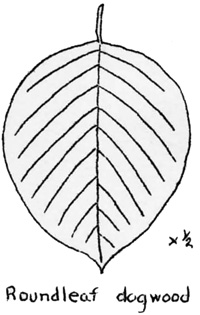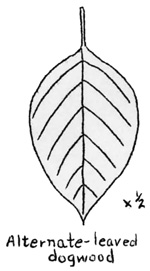

|
|
NATURE NOTES FROM ACADIA
By Arthur Stupka, Park Naturalist SECTION II. DECIDUOUS TREES (continued) Four species of maples are native to the region of Acadia National Park. Two of these species, the mountain and the striped maples, can be regarded as shrubs or small trees, whereas the sugar and the red maples often grow to be of large size. All have simple leaves which are lobed and, with the exception of the sugar maple, serrate. The fruits of all are paired winged seeds, sometimes called "keys" or "samaras." The mountain maple (Acer spicatum) bears a close resemblance to the moosewood. It is a small shrubby tree whose three-lobed leaves are usually smaller in size and have larger and coarser teeth along their margins. Whereas its flowers are arranged in erect many-flowered racemes, those of the moosewood are in lesser-flowered drooping racemes. The bark of the mountain maple is not marked by thin white lines. The striped maple (A. pennsylvanicum), sometimes called moosewood, has the largest leaves in this group. These leaves have three short pointed lobes, a rounded base, and serrate margins. The bark of the tree is dark green or reddish brown or both, marked with whitish lines which run lengthwise. The young twigs are smooth and greenish. Both these small maples prefer moist rocky hillsides where they demand the shade of larger trees. The sugar maple (A. saccharum), valued as a timber, ornamental, and sugar tree, is readily distinguished by its broad simple leaves which are usually five-lobed, the lobes sparingly toothed. It is a fairly common tree, preferring rich soils where it grows to a large size. The most colorful of our maples is the red, swamp, or soft maple (A. rubrum), an abundant species in this region. In the spring its clusters of scarlet flowers are unfurled before the blossoms of most native plants put in their appearance and result in a most beautiful floral display. Again in late summer and early autumn the leaves of this tree, turning to shades of scarlet, account for some of tho brightest masses of our changing leaf color. The red maple thrives best in wet soil and may form extensive stands in swamps.

Omitting the common very low-growing bunchberry or dwarf dogwood, but two other species of the genus Cornus are to be found here and both are shrubs or small trees. The roundleaf dogwood (Cornus rugosa) is characterised by its broadly ovate opposite leaves and light blue to whitish fruits. The alternate-leaved or blueberry dogwood (C. alternifolia) has ovate alternately-arranged leaves which are narrower than those of the preceding species. Its fruits are considerably darker in color than those of the roundleaf dogwood. Leaves of dogwoods are characterised by the prominence of the midrib and primary veins. 
Two ashes, the black (Fraxinus nigra) and the white (F. americana), are to be found growing here. Both have compound opposite leaves which consist of 7 to 11 leaflets; on the white ash these leaflets are borne on short stalks whereas on the black ash the leaflets are without stalks. Both species bear clusters of winged paddle-like seeds which may persist on the trees for some time into the winter. The ashes prefer to grow in rather moist fertile soils where occasionally they become very large. Their leaves appear rather late in the season, following the dark-colored flower clusters. In the autumn the purplish tints which the foliage of our ashes assumes is very beautiful.
SUMMARY OF THE KINDS OF TREES IN ACADIA NATIONAL PARK
|
| <<< Previous | > Cover < | Next >>> |
nature_notes/acad/vol3-3b.htm
09-Jan-2006